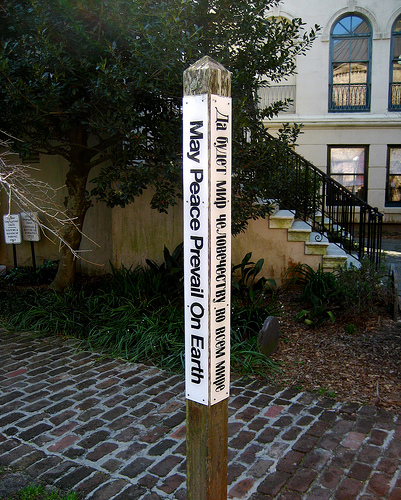A Peace Pole is a monument declaring the message "May Peace Prevail on Earth" in the language of the country in which it is planted and usually several other languages. Peace Poles were created 1955 in Japan by Masahisa Goi, in wake of the destruction wrought by World War II and the atomic bombs dropped on Hiroshima and Nagasaki. Devastated by the repercussions of war, Goi wished to spread a message of peace worldwide. The phrase "May Peace Prevail on Earth" is attributed to Goi, and peace poles were constructed across Japan. In the 1980s, peace poles began appearing outside of Japan, and now can be found around the world. Peace poles are typically erected on the sites of hate crimes or other acts of violence as a counter-message of peace and unity.
Peace poles come in many forms, but they are usually a simple wooden stake with the phrase "May Peace Prevail on Earth" on each side of the stake, in four different languages.
You can purchase a professionally made Peace Pole, or you can make your own.
Materials for Making a Peace Pole
- One 4x4 or 6x6 post
- Paint (exterior-type)
- Paintbrush (for lettering)
- Text translation templates (optional)
- Deck treatment or other wood preservative
- Posthole digger
- Gravel
- Cement mix
- Fence post level
Making a Peace Pole
- Choose which four languages you wish to display on your homemade Peace Pole. Find translations in many languages here. You can either do the lettering freehand, or you can use your computer to make a template of the phrase. If you make a template, outline the block letters with a pencil directly on the wood and paint the letters in.
- If you are feeling particularly creative, decorate your Peace Pole with your own designs.
- After the letters have dried, preserve the Peace Pole with something like deck treatment to prevent damage from the elements.
- You can leave the top square, cut a pyramid shape in the top, or add something like a wooden ball on top.
Planting a Peace Pole
- Find where you would like to plant your Peace Pole (you can always plant it in a pot if digging in the yard is not an option).
- Using a posthole digger, dig a hole two feet deep.
- Put gravel in the bottom of the hole and pack the dirt back in around it, using a fence post level to make sure the Peace Pole is straight.
- For a more permanent planting, pour cement in around it to set the pole, and cover the cement with some of the removed dirt.
Learn more about the Peace Pole project from the World Peace Prayer Society or specifics about making your own.
Top photo of a Peace Pole at the pyramids at Giza, Egypt via worldpeace.org
